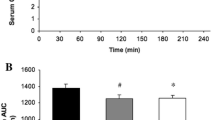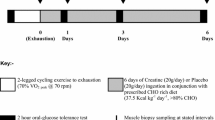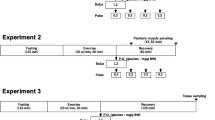Abstract
This study investigated the percentage of carbohydrate utilization than can be accounted for by glucose ingested during exercise performed after the ingestion of the potent lipolysis inhibitor Acipimox. Six healthy male volunteers exercised for 3 h on a treadmill at about 45% of their maximal oxygen uptake, 75 min after having ingested 250 mg of Acipimox. After 15-min adaptation to exercise, they ingested either glucose dissolved in water, 50 g at time 0 min and 25 g at time 60 and 120 min (glucose, G) or sweetened water (control, C). Naturally labelled [13C]glucose was used to follow the conversion of the ingested glucose to expired-air CO2. Acipimox inhibited lipolysis in a similar manner in both experimental conditions. This was reflected by an almost complete suppression of the exercise-induced increase in plasma free fatty acid and glycerol and by an almost constant rate of lipid oxidation. Total carbohydrate oxidation evaluated by indirect calorimetry, was similar in both experimental conditions [C, 182, (SEM 21); G, 194 (SEM 16) g · 3 h−1], as was lipid oxidation [C, 57 (SEM 6); G, 61 (SEM 3) g · 3 h−1]. Exogenous glucose oxidation during exercise G, calculated by the changes in13C:12C ratio of expired air CO2, averaged 66 (SEM 5) g · 3 h−1 (19% of the total energy requirement). Consequently, endogenous carbohydrate utilization was significantly smaller after glucose than after placebo ingestion: 128 (SEM 18) versus 182 (SEM 21) g · 3 h−1, respectively (P < 0.05). Symptoms of intense fatigue and leg cramps observed with intake of sweet placebo were absent with glucose ingestion.
In conclusion, we found glucose ingestion during 3-h exercise with lipolysis blockade could provide metabolic substrate permitting a significant sparing of endogenous carbohydrate and consequently an improvement in performance.
Similar content being viewed by others
References
Barstow TJ, Cooper DM, Epstein S, Wasserman K (1989) Changes in breath13CO2/12CO2 consequent to exercise and hypoxia. J Appl Physiol 66:936–942
Calloway DH, Odell CF, Margen S (1971) Sweat and miscellaneous nitrogen losses in human balance studies. J Nutr 101:777–786
Craig H (1957) Isotopic standards for carbon and oxygen and correction factors for mass spectrometric analysis of CO2. Geochim Cosmochim Acta 12:133–149
Crepaldi G, Avogaro P, Descovich GC, Di Perri T, Postiglione A, Sirtori CR, Strano A, Ventura S, Musatti L (1988) Plasma lipid lowering activity of acipimox in patients with type II and type IV hyperlipoproteinemia. Results of a multicenter trial. Atherosclerosis 70:115–122
Fuccella L, Goldaniga G, Lovisolo P, Maggi E, Musatti L, Mandelli V, Sirtori CR (1980) Inhibition of lipolysis by nicotinic acid and by acipimox. Clin Pharmacol Ther 28:790–795
Gautier JF, Pirnay F, Jandrain B Lacroix M, Mosora F, Scheen AJ, Lefèbvre PJ (1993) Endogenous substrate oxidation during exercise and variations in breath13CO2/12CO2. J Appl Physiol 74:133–138
Gérard J, Jandrain B, Pirnay F, Pallikarakis N, Krzentowski G, Lacroix M, Mosora F, Luyckx AS, Lefèbvre PJ (1986) Utilization of oral sucrose load during exercise in humans. Effect of the α-glucosidase inhibitor Acarbose. Diabetes 35:1294–1301
Hargreave M, Costill DL, Coggan A, Fink WJ, Nishibata I (1984) Effect of carbohydrate feedings on muscle glycogen utilization and exercise performance. Med Sci Sports Exerc 16:219–222
Ivy JL, Costill DL, Fink WJ, Lower RW (1979) Influence of caffeine and carbohydrate feedings on endurance performance. Med Sci Sports Exerc 11:6–11
Jacobson BS, Smith BN, Epstein S, Laties EG (1970) The prevalence of carbon 13 in respiratory carbon dioxide as an indication of the type of endogenous substrate. J Gen Physiol 55:1–17
Jandrain B, Krzentowski G, Pirnay F, Mosora F, Lacroix M, Luyckx A, Lefèbvre P (1984) Metabolic availability of glucose ingested 3 h before prolonged exercise in humans. J Appl Physiol Respir Environ Physiol 56:1314–1319
Jandrain B, Pirnay F, Lacroix M, Mosora F, Scheen AJ, Lefèbvre PJ (1989) Effect of osmolality on availability of glucose ingested during prolonged exercise in humans. J Appl Physiol 67:76–82
Jandrain B, Pallikarakis N, Normand S, Pirnay F, Lacroix M, Mosora F, Pachiaudi C, Gautier JF, Scheen AJ, Riou JP, Lefèbvre PJ (1993) Fructose utilization during exercise in men: rapid conversion of ingested fructose to circulating glucose. J Appl Physiol 74:2146–2154
Krzentowski G, Pirnay F, Luyckx AS, Pallikarakis N, Lacroix M, Mosora F, Lefèbvre PJ (1982) Metabolic adaptations in postexercise recovery. Clin Physiol 2:277–288
Krzentowski G, Jandrain B, Pirnay F, Mosora F, Lacroix M, Luyckx AS, Lefèbvre PJ (1984a) Availability of glucose given orally during exercise. J Appl Physiol Respir Environ Exerc Physiol 56:315–320
Krzentowski G, Pirnay F, Luyckx AS, Mosora F, Lacroix M, Lefèbvre PJ (1984b) Effect of physical training on utilization of a glucose load given orally during exercise. Am J Physiol 246[Endocrinol Metab 9]:E412-E417
Lacroix M, Mosora F, Pontus M, Lefèbvre P, Luyckx A, Lopez-Habib G (1973) Glucose naturally labeled with carbon-13: use for metabolic studies in man. Science 181:445–446
Lefèbvre JP, Mosora F, Lacroix M, Pirnay F, Scheen A, Krzentowski G, Jandrain B, Gautier JF, Pallikarakis N, Riou JP, Normand S, Pachiaudi C, Khalsallah Y (1991) Use of13C substrates for metabolic studies in exercise: methodological considerations (letter to the Editor). J Appl Physiol 71:2059–2060
Lusk G (1928) The science of nutrition. Saunders, Philadelphia
Luyckx AS, Pirnay F, Lefèbvre PJ (1978) Effect of glucose on plasma glucagon and free fatty acids during prolonged exercise. Eur J Appl Physiol 33:53–61
Massicotte D, Péronnet F, Pitre C, Adopo E, Brisson GR, Hillaire-Marcel C (1993) Exogenous13C glucose oxidation during exercise: North American vs Western European studies. Eur J Appl Physiol 67:402–407
Mosora F, Lefèbvre P, Pirnay F, Lacroix M, Luyckx AS, Duchesne J (1976) Quantitative evaluation of the oxidation of an exogenous glucose load during naturally labeled13C glucose. Metabolism 25:1575–1582
Pallikarakis N, Jandrain B, Pirnay F, Mosora F, Lacroix M, Luyckx A, Lefèbvre PJ (1986) Remarkable metabolic availability of oral glucose during long-duration exercise in humans. J Appl Physiol 60:1035–1042
Pernow B, Saltin B (1971) Availability of substrates and capacity for prolonged heavy exercise in humans. J Appl Physiol 31:416–422
Péronnet F, Massicotte D, Brisson G, Hillaire-Marcel C (1990) Use of13C substrates for metabolic studies in exercise: methodological considerations. J Appl Physiol 69:1047–1052
Pirnay F, Lacroix M, Mosora F, Luyckx AS, Lefèbvre P (1977a) Glucose oxidation during prolonged exercise evaluated with naturally labeled13C glucose. J Appl Physiol Respir Environ Exerc Physiol 43:258–261
Pirnay F, Lacroix M, Mosora F, Luyckx A, Lefèbvre P (1977b) Effect of glucose ingestion on energy substrate utilization during prolonged muscular exercise. Eur J Appl Physiol 36:247–254
Pirnay F, Crielaard JM, Pallikarakis N, Lacroix M, Mosora F, Krzentowski G, Luyckx AS, Lefèbvre PJ (1982) Fate of exogenous glucose during exercise of different intensities in humans. J Appl Physiol Respir Exerc Physiol 53:1620–162
Walker M, Cooper BG, Elliott C, Reed JW, Orskow H, Alberti KGMM (1991) Role of plasma non-esterified fatty acids during and after exercise. Clin Sci 81:319–325
Wagenmakers AJM, Rehrer NJ, Brouns F, Saris WHM, Halliday D (1993) Breath13CO2 background enrichment during exercise: diet-related differences between Europe and America. J Appl Physiol 74:2353–2357
Winer BJ (1962) Statistical principles in experimental design. McGraw-Hill, New York, pp 267–271
Zerbe GO (1979) Randomization analysis of the randomized design extended to growth and response curves. Commun Stat 2:191–205
Author information
Authors and Affiliations
Rights and permissions
About this article
Cite this article
Gautier, J.F., Pirnay, F., Jandrain, B. et al. Availability of glucose ingested during muscle exercise performed under acipimox-induced lipolysis blockade. Europ. J. Appl. Physiol. 68, 406–412 (1994). https://doi.org/10.1007/BF00843737
Accepted:
Issue Date:
DOI: https://doi.org/10.1007/BF00843737




